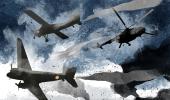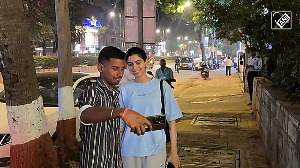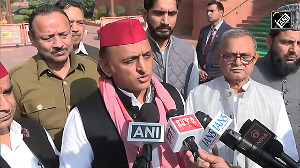'My adrenalin kicked in and the happiness returned! It was time to go in for the kill again.'
IAF Veterans Group Captain Dilip Kumar Dass tells Air Commodore Nitin Sathe about how the IAF decimated tanks in the famous Battle of Longewala.
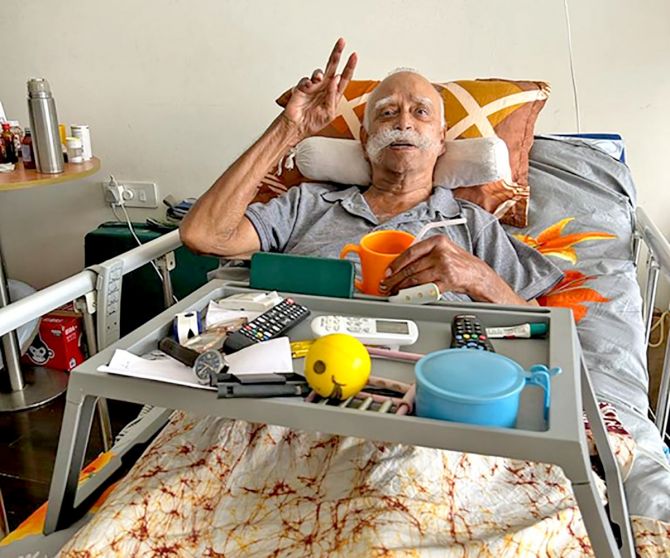
I was introduced to Group Captain Dilip Kumar Dass, a veteran Indian Air Force officer, courtesy the Air Veterans Association.
In the 10 odd minutes I spoke to him, I was mesmerised by his josh and quest for life as well as his excellent memory.
He had participated in the famous Battle of Longewala in December 1971, and before long, I fixed up an appointment with him to listen to him speak about his experiences of the 1971 War.
The two hours spent with him went like a fighter in combat -- too fast and too mesmerising. I had the privilege of recording some 'spoken war history'...
"By the time I came back after dropping my wife at Calcutta for the arrival of our first child, two aircraft had already deployed from Jamnagar to Jaisalmer with Wing Commander 'Minhi' (Mohinder Singh) Bawa posted in as the base commander," Group Captain Dass recalls, telling me his story between sips of sweet lime juice, lying on his special bed at a senior citizen's home in Kharadi, Pune.
"I was eager to see action and as soon as the opportunity presented itself, I flew in to Jaisalmer along with a young Under Trainee Pilot Officer in a Hunter trainer."
They had flown in with four additional underwing fuel tanks with guns loaded -- flying at tree-top heights, crossing over into enemy territory before coming in to land at Jaisalmer.
"If the war had to start, I wanted it to start it with this incursion!" the group captain says, his eyes gleaming, radiating mischief.
As they landed in Jaisalmer, they saw the radical changes that the station had undergone under the new commander.
"After taking over, Bawa had gotten down to getting the derelict base to war-readiness as also logistically capable of handling the vast influx of arms, ammunition and men from various units who started coming in from as early as August-September 1971, as part of the augmentation plan."
Jaisalmer came under the operational and administrative control of Jodhpur and therefore, Bawa went to meet the boss there for help.
Jodhpur was busier than Jaisalmer -- preparing itself for war; and it was impossible for the commander there to spare any assistance.
Bawa, therefore, sought help from the local district administration at Jaisalmer.
"The district commissioner was a fantastic guy... he was a regular visitor to our base and we were able to garner a fair amount of intelligence from him about what was happening in government circles as well as near the border and across."
The district commissioner ensured that the administration went all out to make sure that the mundane tasks of handling the loads as well as creating the temporary infrastructure and carrying out cleaning and repairs was carried out by the local civilians.
"Thanks to his efforts, we were war-ready by October 1971 and awaited news of the balloon going up."
The part of Operational Training Unit (OTU) that went to Jaisalmer from Jamnagar was designated as 122 (Ad-Hoc) Squadron led by then Wing Commander D M Conquest, Ati Vishisht Seva Medal, Vir Chakra.
When the war started on the 3rd of December 1971, the base had six fighters (single seater) and one twin seater trainer aircraft.
While most of the under trainee pilot officers of the unit were deployed as Forward Air Controllers all over the desert, six of them were sent to Jaisalmer to man the operations room.
The senior pilots of the unit were masters on the aircraft and used the pre-war preparatory training to carry out 'on the job' conversion training of the young Pilot Officers.
'By November, all of us knew the desert like the back of our hands'.
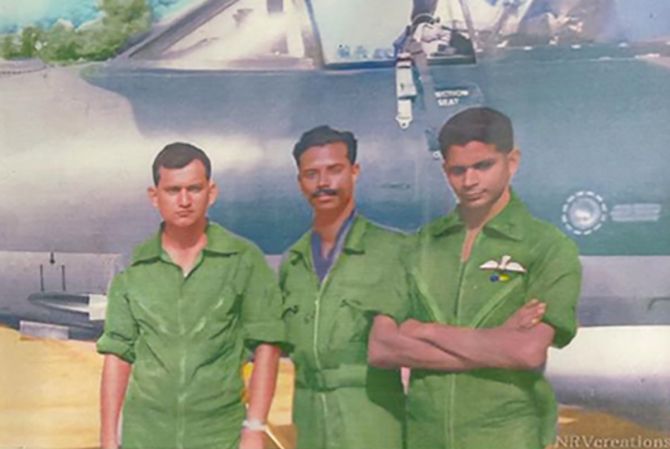
The Jaisalmer airfield was located close to the Jaisalmer fort in the middle of the Thar desert. Jaisalmer was strategically important for the Pakistanis as well as for the Indians.
The desert in those times was bereft of vegetation, and small villages tucked away in between shifting sand dunes made navigation difficult.
However, in the area north of base, a metalled road did exist between Jaisalmer to Tanot and Longewala via Ramgarh, and this was visible from miles awat.
This road was to help pilots navigate to and from the scene of action.
"While navigating in the desert with the navigation equipment we had on board in those times, if you went off by a degree, you could get completely lost!" exclaims Group Captain Dass.
"When I left Jamnagar, I visualised that due to the sheer number of people deployed at Jaisalmer, the administrative support would be stretched to the limit. So, before I took off, I went to the canteen and picked up lots of bottles of pickle as well as tins of Milkmaid. These were sent across with the ground crew and served us well later. A couple of rotis with the pickle and
There was no dedicated mess for the officers at the base, and the airmen's mess cookhouse served the officers and men decent food despite the shortages. With good local liaison, the airmen did manage some meat from the locals once a while, which was a welcome change.
All evenings were spent in and around the ops room and the discussions would veer away from the war to geography and politics over a few drinks.
The ops room also served as their rest room and mess. The youngsters had so much to learn from stalwarts like Bali, Jagbir Singh, Sunderesan, S D L Tully, Cawasjee and others; most of who went on to become icons of the IAF.
"My job also involved taking the rickety jeep across to the mess and get the big tiffin full of food for the officers at night. It was blackout time and the headlights could not be used; and by, I came to be familiar with each of the electric poles on the way, and these served as my navigation markers in the pitch dark conditions."
The IAF group were joined by the Indian Army's Air Observation Post (AOP) pilots and ground crew who came in with their slow moving Krishak aircraft and flew extensively in the area.
Their job was to direct artillery fire on to the enemy. "Major Atma Singh and Captain Sanga joined us and gave us an insight into what was happening in the deployed army units," recalls the IAF veteran.
"I remember Atma came to me one day and expressed that he wasn't too sure of the tactics to ward off a Pakistani fighter threat."
It was decided to give the army pilots some practical training in combat.
They were taken in the trainer aircraft in formation. While the fighter acted as the Pakistani attacker, the trainer maintained slow speeds to simulate the Krishak.
"We showed our friends how to turn into the attacker to give him maximum crossing speeds as well as difficulty in tracking for a shoot. As the fighter crossed over at high speeds, he would lose sight of the Krishak and take time to turn around -- this gave ample time to the slow moving aircraft to duck down to deck level making spotting difficult."
"Very soon, the pilots were conversant with the tactics and also thrilled at having flown in a jet aircraft. They were now fairly confident of warding off the enemy if and when it happened. This exercise also increased the bonhomie and understanding between us, something that was most important in war."
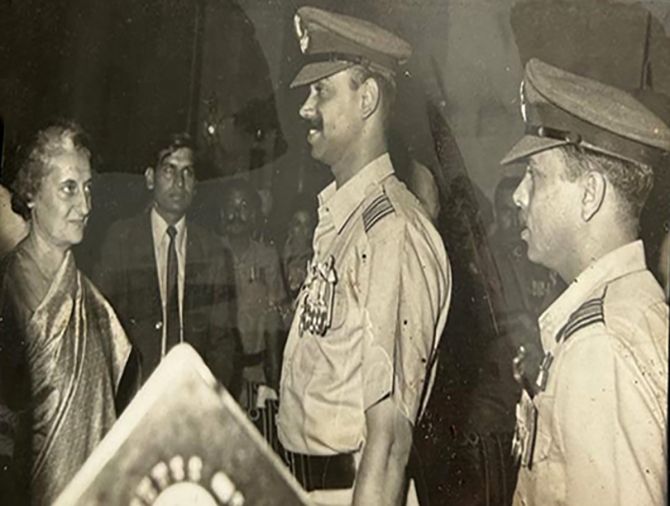
Come mid-November, temperatures were dropping and the desert got pretty cold at night. But going by the news that was coming in, things were hotting up on both the eastern and western fronts and minor skirmishes were taking place with regularity.
"We now slept in our flying overalls sans our boots in the semi-underground ops room in the company of large desert rats which came in search of food and warmth. Our common pastime post dinner was to practise 'deflection shooting' of the rats using our boots!"
"It was the third of December and Ramesh Gosain and I were on ORP (Operational Readiness Platform) duty, ready to take off to ward off any air attack by the Pakistani air force. The ORP had been on for some time now from dawn to dusk," the IAF veteran recalls.
"The Hunter aircraft was not cleared for night operations and therefore, we had nothing do with flying after the sun went down the dunes."
That evening, at the ops room, Bawa rang up Dass and informed him that the Pakistan air force had struck various bases in the western sector.
"I, for one, was thrilled! We had waited for so long for this to begin so that we could make mincemeat of the Pakistanis. I rang up the ops room from the ORP and told the boys that they should wait for me to come over, and the first drink that evening was on me!"
The ORP readiness at sunset came to standby-2 which meant that the pilots had to remain strapped up in the cockpit, ready to get airborne in two minutes of a warning.
"It was getting dark, and we were uncomfortable in the cockpit, wanting to sort out our bursting bladders; but Bawa, in his own wisdom, asked us to continue on the readiness in the cockpit till it was completely dark."
As soon as they got to the ops room, all of them, with a drink in their hand, gathered around a small radio waiting to hear about the formal announcement of war.
The communication networks were poor and the fastest way of getting information was the good old All India Radio.
"We went about planning for the next day's missions based on the intelligence that had been provided, expecting the 'code red' to arrive sooner than later."
The DC had been called for dinner that night and he had promised to get a few teetars (a partridge, a bird found in abundance in the desert) from his trip to the border towns that day.
"I still remember the fantastic partridge-meat dinner that we had that night, just before Prime Minister Indira Gandhi formally declared war."
"We did not have much to do on the first morning of the war, except waiting to thwart a Pak-air attack and launch strikes when ordered."
"On the evening of the 4th, Jagbir and Kapoor were sent on a recce mission along the border near Tanot area. On their way back they spotted a large gathering of camels. It appeared that there were no human beings accompanying this large flock of animals and it looked suspicious. They decided to have a go at the herd, opening up with their front guns."
"I do not know how many camels were killed that evening, but later, we found out that it was the Razakars (Pakistani militia-collaborators with the Pakistani army) who had infiltrated into our area."
The flying plan for the 5th was similar as the one that was made for the 4th December, but since the battle was hotting up, air raids were expected during day and night and the base had to be kept on high alert.
That night, as they just gathered together for dinner after the plans for the next day were finalised and briefed, a call from the Army 12 Division HQ caused a fair amount of excitement in camp.
"The base commander was on a long call with the boss of 12 Infantry Division on the army line. Heated discussions were overheard and we waited for him to tell us what was happening."
Soon, Bawa walked into the briefing room and told them to keep all the other plans on hold.
Some new intelligence inputs had just been received. He went on to get further confirmation from the Army.
"'As per the Army four to five enemy tanks have been seen in the general area -- Longewala and Ramgarh...', Bawa started the briefing."
Two aircraft were planned for pre-dawn take-off to recce and get the exact information about the infiltrators.
In the Indian Army plan of action, an attack had been planned well north of Longewala near Islamgarh with an aim to capture Rahim-Yar-Khan; and this plan was now going to get delayed since forces had to be moved to support and reinforce the only company of 23 Punjab regiment guarding Longewala sector, a sector where the action had been least expected."
"It was pitch dark when we jumped into the jeep to reach the aircraft the next morning. Gosain was planned as my No. 2 with rockets and front guns loaded. The ground grew, who would have reached there just past midnight to get the aeroplanes ready, encouraged us and wished us good shooting."
'Clear to taxi, line up and take off!' said the ATC controller as soon as Dass asked for clearance. He also seemed to be in a hurry to see the aircraft take to the skies.
"I told Gosain to stagger his take off by around 10 seconds behind me. We navigated to the runway following the white centre line in pitch darkness and I took off with my navigation lights on to help Gosain to catch up in formation."
The fort at Jaisalmer stood out like a ghost in the darkness and so did the black road heading towards Ramgarh as they flew towards the general area to search for their targets.
"We were flying at tree-top levels, and while the sky lightened up with the first rays of the morning sun, we eased up to scan the area. After a while of searching, I noticed some matchbox like structures standing out in the desert sands. They looked like tanks to me, but just to be sure, I asked Gosain to confirm, which he did."
As they got closer, they noticed puffs of smoke and dust emanating from the tanks in the distance. They had been noticed; the ack-ack guns mounted on the tanks had started firing at them-some of the tracers marking streaks of white.
"We gained height to 3,000 feet to keep clear of these guns and I gave a quick call to the ATC on the radio to relay our sighting. There was no response from ATC, and we continued to orbit over the area, counting the number of tanks and transmitting the same on the radio, hoping that someone would hear us."
Five tanks? There were more than 30 of them milling around the area!
"I checked my switches and went in for a live pass at the lead tank diving from about 3,500 feet, and I asked Gosain to give me tail clearance till I did the shooting. I had selected to fire 4 rockets in salvo; and screaming in at 400 knots (720 kmph) at the correct distance, I squeezed the trigger."
The moment the rockets left the pods, it was clear to Dass that he would get the tank, and this was confirmed by Gosain a few seconds later as Dass pulled out of the dive.
'Direct Hit!' he shouted on the radio happily.
Dass was on cloud nine with his first kill; the commander's tank had been taken out. His euphoria and happiness was cut short by Gosain, who, while flying over the smouldering remains of the tank radioed: 'It appears to be an Indian one sir!'
"My heart sank and my blood drained down to my boots at the rudder pedals. Oh my God! I had killed one of my own and would surely face a court martial soon. I pulled up to 5,000 feet to give a call to the ATC and tell them about what had happened."
There was, again, no response from ATC. In fact, the ATC was able to hear Dass, but Dass had trouble hearing the ATC acknowledging his calls.
The aircraft receiver obviously had a problem; it could hear the aircraft only in close vicinity.
"As we flew around thinking about the next course of action, I heard a faint voice on the radio. It was our friend, Capt Sanga, flying in his Krishak. I requested for his position and directed him towards the tanks to re-confirm if they were Indian."
It was such a relief when Sanga confirmed that the tanks were, indeed the enemy.
"My adrenalin kicked in and the happiness returned! It was time to go in for the kill again. I did three more attacks with my rockets, but my aim this time wasn't too good."
"I asked Gosain to go in for his rocket attack after I had finished."

After they had expended the rockets, it was time to go in for the gun attack.
The guns of the Hunter were quite accurate. Added to that, the Pakistani tanks had extra fuel barrels strapped on to their backs; and when the high explosive bullets found their mark, the entire tank was engulfed in flames.
With no air threat in the area, the field was now open for the IAF aircraft to decimate as many tanks as they could.
When the formation left the battleground with no ammunition left, the area could be seen from miles due to thick black smoke.
"I had lost sight of Gosain in the firing melee and asked him to return to base on his own. As I turned towards Jaisalmer, my radio completely gave up and so did my hydraulics. I landed the partially crippled aircraft soon after Gosain, to be greeted by a happy Station Commander and all my colleagues."
By the time the pair landed, Bawa, having followed the battle closely, had already launched two more aircraft to the battle area, not wanting to reduce the pressure. And as the aircraft found success in each mission, the sorties continued unabated the whole day.
"Initially we were sending the aircraft in pairs for mutual support, but when we found that the Pakistani armour had no one to defend them from the air, we stared sending single aircraft missions; soon as an aircraft was refuelled and re-armed, it was on its way. It also ensured that the target area had an aircraft overhead at all times, ensuring that the enemy heads were kept down."
Bawa decided to send the trainer into the battle area with the aim of giving the young trainee pilots a taste of actual battle.
These trainers could carry fewer rounds of the guns along with the rockets, and replenishment took much longer after each sortie.
In the fighter, it was a 'gun-pack' that was slapped on, an operation that took less than 10 minutes.
This wasn't the case with the trainer since it was not designed for fitment of a gun-pack.
"I took up Pilot Officer Brar as my co-pilot and Flight Lieutenant Deepak Yadav as my No. 2 for a live mission in the afternoon. Young Brar was thrilled to get live target firing practice and did fairly well for a beginner! We also took on the receding armour towards Pakistan before returning to base."
From the third wave or so, the Pakistani tanks had been seen retreating into their own territory.
It was decided that all missions would take on whatever targets were left in the battle area and then follow their tracks across the border.
Here, they found a large number of vehicles who were part of the logistics train, bringing in water, food, ammunition and other administrative requirements for the Pakistani armour and infantry.
"These 'soft' targets were destroyed by some accurate firing by our boys. The entire area of Longewala and the route into Pakistan were littered with destroyed and abandoned vehicles and the picture was one like what is shown in movies."
In one sortie, while Dass went around taking on the logistics train, he was late to pull out of a dive and missed hitting a sand dune by a whisker.
"I climbed to 8,000 feet after this for a breather; another one second delay in my reaction would have been the end of me!"
Cawasjee had other ideas when it came to taking on these lighter vehicles. He flew over the line of vehicles a couple of times to allow their occupants to clear the area and then went about strafing them, taking keen interest in destroying the water bowsers.
"When I asked him why he was letting the Pakistanis go, he smiled and told me, 'I want those bastards to walk back home without water and food!'"
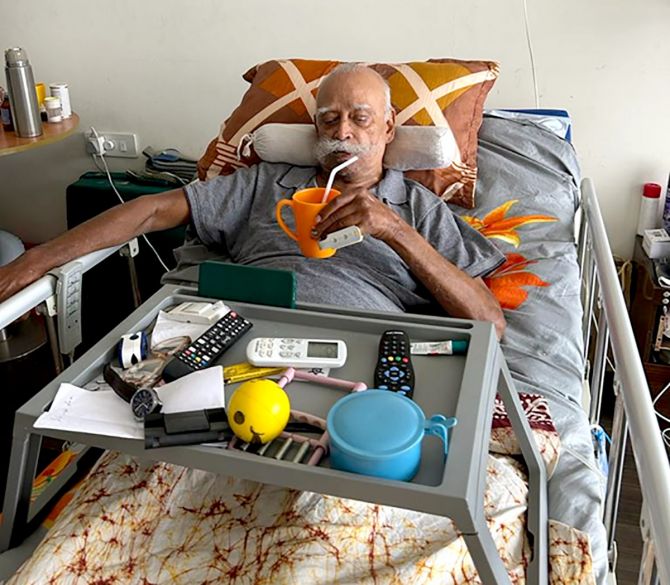
The Battle of Longewala for the IAF lasted for December 5.
Some more sorties were flown on the following days, but the major damage had already been inflicted on day one making the Pakistanis retreat.
The brave pilots of 122 Squadron had risen to the occasion and nullified a brutal attack by the Pakistani armour in Longewala.
"I wish we had deputed one of the Pilot Officers at the Ops Room to record history as it unfolded, but, as they say, hindsight is 20/20!'
Many 1971 veterans have been narrating their stories of this finest of victories of 1971; but in the years gone by, memories have faded and a few details lost, some questions remaining unanswered.
"At 85, and with my memory playing hide and seek, I can still manage to recount the superlative performance of the Indian Air Force in the Battle of Longewala as if it happened yesterday!" says Group Captain Dass.
"What I have told you is as I remember it, and this is as real as I can tell!"
"Yes, there have been controversies over who did what, and who did or did not get his due; but I for one would like to bury all those differences and say that it was the joint efforts of the Army and the IAF that led to this resounding victory; and, I am proud to have been in the thick of it."
Epilogue
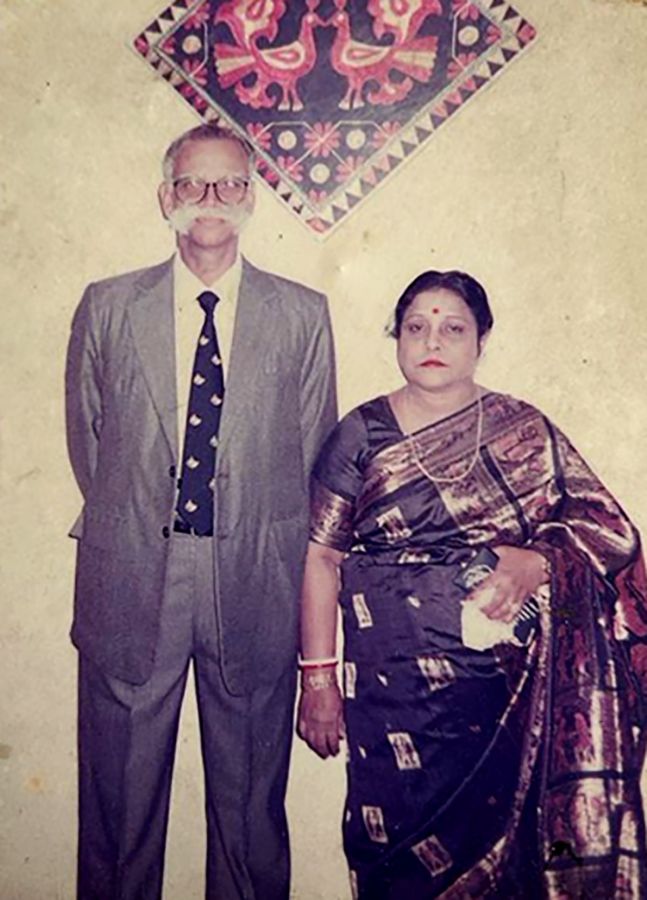
A Bengali by birth, Group Captain Dilip Kumar Dass was born in 1939 and bought up in Tamil Nadu where his father moved with family south of Madurai to set up a mill producing surgical cotton in his early years. He was the eldest of 8 children -- four girls and four boys.
He went to a village school, studied Tamil, and being brought up in that atmosphere, became a die-hard Tamilian, both in his language as well as in his thinking.
Being very good in science subjects, he joined college to pursue a career in science, but had to leave half way due to family commitments.
Because of his academic brilliance, it was easy for him to join the IAF which he did as an airman in the radio trade and was first posted to Delhi in the Signal centre.
As an airman, he excelled in whatever work was given to him and therefore his superiors motivated him to join the service in the officer cadre.
He tried three times at the Services Selection Board, but failed to get through.
Not to be dismayed, he started studying hard to enter the officer cadre in the technical entry scheme.
A sudden and dramatic turn of events found him headed for Jodhpur to join the pilot's course.
The IAF had reconsidered a number of airmen who had failed at the SSB to join, and he was the chosen lucky one!
There was no looking back for the young man once his flying training commenced.
He topped the course in his basic as well as advanced stage and was awarded the President's medal for standing first in the overall order of merit.
Group Captain Dilip Kumar Dass was awarded the Vir Chakra for his bravery in the famous battle of Longewala.
His citation reads thus...
'During the operations against Pakistan in December, 1971, Squadron Leader Dilip Kumar Dass as a pilot in a Fighter Bomber Squadron, flew a number of operational missions. On the 5th December, 1971, he was detailed on a mission to destroy a massive enemy thrust spear headed by a tank regiment at Longewala. He carried out three strike missions on 5th the December and one on the 6th December, 1971, and destroyed four tanks, a number of vehicles and troop concentrations despite heavy ground fire. His missions had a decisive effect in frustrating the enemy thrust.
Throughout, Squadron Leader Dilip Kumar Dass displayed gallantry, professional skill and devotion to duty of a high order.
A helicopter pilot who served the IAF for 35 years, IAF Veteran Air Commodore Nitin Sathe is a frequent contributor to Rediff.com.
You can read his earlier articles here.
Feature Presentation: Rajesh Alva/Rediff.com



